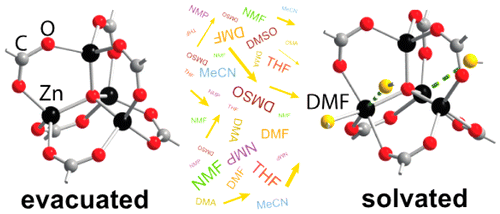Multinuclear solid-state nuclear magnetic resonance, mass spectrometry, first-principles molecular dynamics simulations, and other complementary evidence reveal that the coordination environment around the Zn2+ ions in MOF-5, one of the most iconic materials among metal–organic frameworks (MOFs), is not rigid. The Zn2+ ions bind solvent molecules, thereby increasing their coordination number, and dynamically dissociate from the framework itself. On average, one ion in each cluster has at least one coordinated N,N-dimethylformamide (DMF) molecule, such that the formula of as-synthesized MOF-5 is defined as Zn4O(BDC)3(DMF)x (x = 1–2). Understanding the dynamic behavior of MOF-5 leads to a rational low-temperature cation exchange approach for the synthesis of metastable Zn4–xCoxO(terephthalate)3 (x > 1) materials, which have not been accessible through typical high-temperature solvothermal routes thus far.
